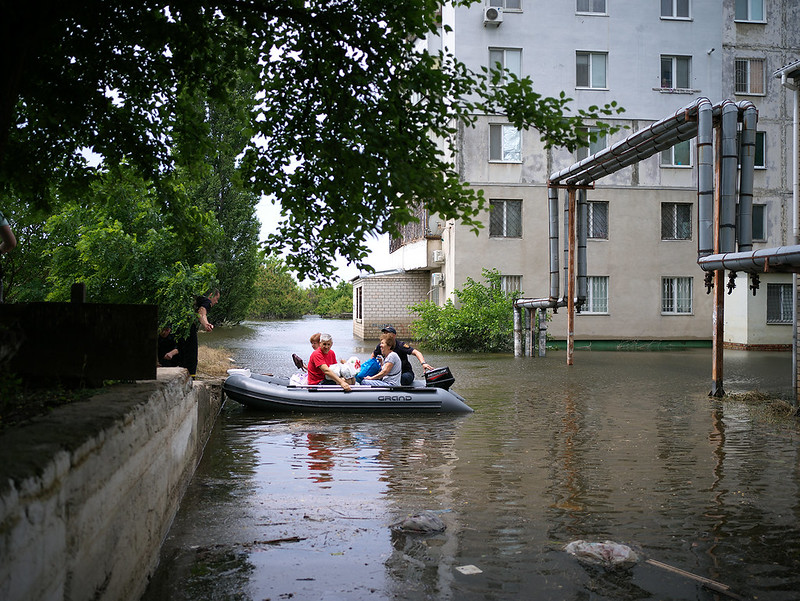Fighting Diseases in Ukraine
 On June 6, 2023, extensive flooding destroyed the Kakhovka Dam in Ukraine, leaving millions of people without running water and exposing them to deadly infectious diseases. Conflict in eastern Ukraine has resulted in more than 20 incidents of damage to water infrastructure in the region alone, exposing the population to deadly infectious diseases like cholera, diarrhea and skin infections. The Kakhovka reservoir was a major provider of water for farmers and residents.
On June 6, 2023, extensive flooding destroyed the Kakhovka Dam in Ukraine, leaving millions of people without running water and exposing them to deadly infectious diseases. Conflict in eastern Ukraine has resulted in more than 20 incidents of damage to water infrastructure in the region alone, exposing the population to deadly infectious diseases like cholera, diarrhea and skin infections. The Kakhovka reservoir was a major provider of water for farmers and residents.
Major cities across Ukraine are experiencing a severe water shortage, resulting in unsanitary living conditions and increased prevalence of diseases. The contaminated water supply has led to the spread of waterborne diseases such as cholera and typhoid, which have become widespread. Additionally, due to poor living conditions, rodent-borne diseases like leptospirosis and tularaemia have affected the population.
Environmental Damage
The impact of water damage on the environment has been another leading cause of Ukraine’s health crisis. David Santillo, a scientist at the University of Exeter in the United Kingdom (U.K.), spoke with the British Broadcasting Corporation (BBC) about water contamination. Santillo told BBC that raw sewage and untreated wastewater released into the soil can expose people to hazardous substances and pollutants. “There’s always potential for more of that contamination to end up being more widely distributed,” said Santillo.
The conflict in Ukraine has caused significant damage to the agriculture sector, leading to a lasting impact on the country’s economy. This has resulted in an increase in the poverty rate, which rose from 5.5% to 24.1% in 2022. A survey conducted in January 2022 revealed that more than 52.8% of people reported a deterioration in their family’s financial situation since the beginning of the conflict. Furthermore, more than 70% of the Ukrainian population has experienced a loss of income.
Humanitarian Aid and Response
Because of the intensity of the conflict, providing humanitarian aid and support to Ukraine has been highly challenging. However, organizations like the United Nations Children’s Fund (UNICEF) have tried to address the impact of war on the population’s health. UNICEF, with support from Citi, an American multinational investment bank, has been working to bring better health to every Ukrainian child.
Similarly, since the start of the conflict, humanitarian organizations led by UNICEF have assisted thousands of Ukrainian citizens. One of these organizations is the Water Sanitation and Hygiene (WASH). WASH has helped to repair infrastructure and provide power to water pumps to provide the population with safe access to clean water.
Efforts to vaccinate against diseases affecting Ukraine have also received support from the World Health Organization (WHO) and the European Union (EU). Thanks to funding from the EU, mobile health care units in the form of buses have been deployed across the country to reach vulnerable groups, including the elderly and those with pre-existing health conditions. The buses are prepared to administer vaccines against the following diseases: COVID-19, measles, hepatitis, polio, Haemophilus influenzae type b, tetanus and diphtheria.
In September 2023, WHO declared that a polio outbreak that had initially begun in 2021 had been officially eradicated in September 2023. However, cases of measles have been increasing since early 2022. Nonetheless, WHO will continue doing everything possible to deliver emergency needs and medical supplies to the Ukrainian population.
Dr. Jarno Habicht, a WHO representative in Ukraine, is one of many medical professionals stressing the importance of continuing Ukraine’s immunization program. “We have to move fast and work together. I can’t repeat enough what we know is efficient, proven and safe to prevent such public health emergencies: vaccination, vaccination, vaccination,” said Habicht.
– Jacob Buckner
Photo: Flickr
